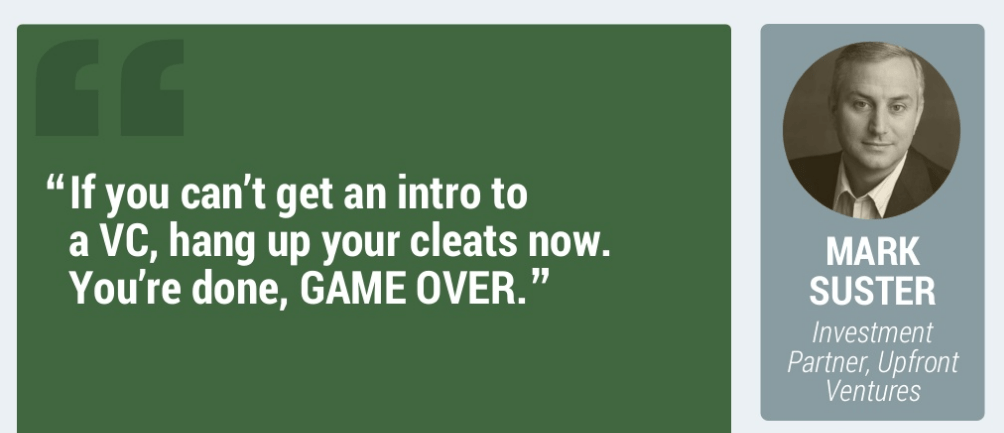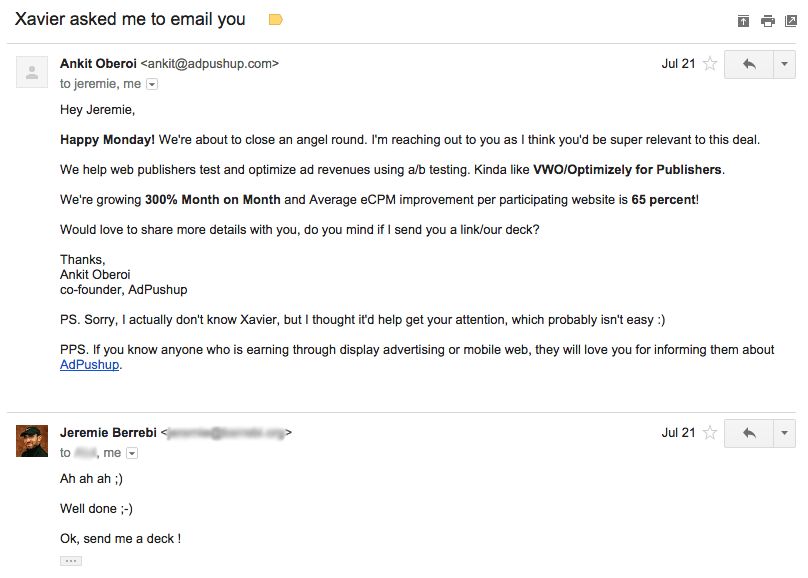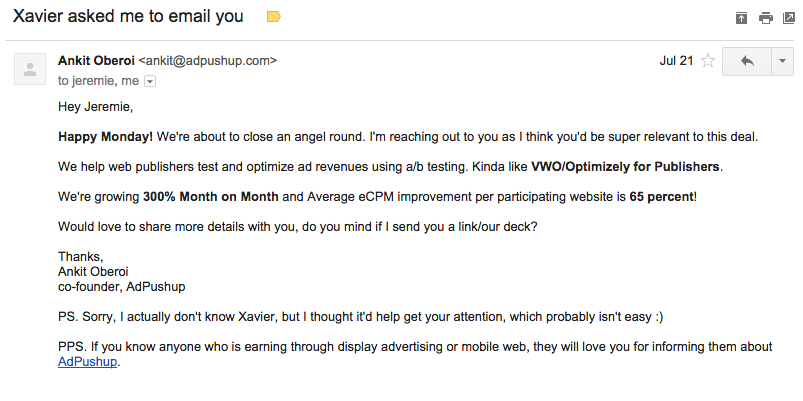How we closed our Angel round of funding, at AdPushup.
Circa June ’14 we knew a total of zero Angel Investors. Fast forward today, we’re proud to announce we have closed $632,000 in investment from 50 Angels. Here’s how we did it and what we learned in the process.
Before sailing out on the fundraising boat, I really wished if more startups had shared how they went about raising funds, especially first-timers.
We recently closed an Angel round, and I’m writing out this post to share all that we learned, the mistakes we made and how we managed to close our first round, without any previous experience of raising capital. In the later part, I’ll boil everything down to what worked and what did not.
Fundraising Mode
By July 2014, we had spent a good 3 months thinking if we should raise funds or bootstrap. Sometimes bootstrapping makes more sense, but it didn’t in our case. So we finally decided to raise funds and close this round ASAP, but there was a problem: None of us had raised funds before and we knew a total of zero Angel Investors.
What we’ve understood is that when raising funds, there’s a passive way to do it and then there is the correct way. Unless you are a successful serial entrepreneur, have amazing traction or media attention; it is rare that passive will work. You are in the fundraising mode when you have at least one of the co-founders actively working on it and it becomes the top idea in your mind.
Before explaining what happened next, here’s how our business benefited just by entering the fundraising mode:
Questions
Investors will question you on every aspect of your business. How strong is the IP? Entry barriers? How is it different from competition? Why isn’t an existing company doing it? – These are generic questions, while domain specialists, will have more niche-specific questions. In our case some of these questions were about the mobile and native ads strategy. These questions are more important for you than anyone else.
As entrepreneurs, we sometimes start believing in our plans so strongly, that we tend to overlook some obvious problems. Therefore, an external view from an outsider might help in highlighting what you may have missed. Such questions will help you understand your business and product better. Also, it’s okay to say that you don’t know the answers yet.
Feedback
You’ll get a lot of feedback on your product and business. We made many additions to our product roadmap, after discussions with some really smart people. For instance, Amit Ranjan told us how they optimized and tested ads on SlideShare during their initial days. One strong feature suggestion came regarding page personalization, which is now on our product roadmap.
Customers or Users
A lot of investors will want to evaluate your product, before they take a call. This is done either by them, a friend or a portfolio company. We got quite a few users this way. It also becomes an easier call for an investor to commit, when they actually know someone who benefited from your product.
Business Plan, Deck and the Pitch
Since the post is about how we managed to raise funds and what worked for us, I’ll keep this section short. While as entrepreneurs we may dislike creating business plans or the documentation around it (at least I did), a comprehensive plan is essential. It helped us bring clarity in our vision towards the business and trust me: this reflects when you talk to people. I can’t stress on this enough.
We thought we knew our business, but when we started writing it down and formalizing it, we realized how little we knew. Just like writing helps refine your thoughts, penning down a business plans helps you:
- Understand your business better.
- Become prepared to answer tough questions and hence, more confident.
- Improve your pitch.
- Improve the long-term vision which trickles down and reflects in your work.

Now do not forget that plans are just that … “plans”. It is unlikely that events and actions will happen exactly as you’ve planned. The objective of writing down a business plan is to understand and differentiate, consciously what you want from your product and what you can deliver. Expecting everything to turn out as you imagined is unrealistic.
Now, What worked for us?
Fundraising Platform: LetsVenture
LetsVenture is an online platform to raise funds. Unlike AngelList, it is easier to get visibility because each new startup begins with a placement on the main listing page. Within two days of completing our profile, I got on a call with Manish and Shanti (Founders of LetsVenture), to expand on who we are and what we do.
The same week, we were asked to pitch in an offline event at Investopad (an amazing co-working space!). This is where we met Sunil Kalra – who’d later become the first angel to commit on the round and support us. This was our first pitch ever and we failed miserably.
A few days later, we bumped into Sunil again at an event he was judging and by then he had already given us a little thought and was interested in knowing more. Now that I think of it, convincing him wasn’t easy at all. We met him about four times and every meeting on an average would be three to four hours long. To prepare for these meetings, a lot of additional work would go in, sometimes weeks. However, it was all worth the effort – Sunil is very supportive and has been very helpful, if we’ve ever asked for any operation help.
In our first scheduled meeting with Sunil, he had also invited Sharad Sharma and we kind of messed up big time – but that’s a story for another time.
However, in just those 20 odd minutes Sharad gave us brilliant and crucial insight about the AdTech industry. This also helped us realize how little we knew about the business we are in.
We realized that we’ll need to explain our product in a more non-jargonistic way and we reached on a conclusion to create a formal business plan. Arun Bansal did quite a bit of work here and helped us narrow down on the outline for each document while Manish would review them. 20% of the round was closed on LetsVenture with the most important first commit coming from them.
Cold Email
Yes, you read it right – Cold Email. Generally, you’ll read and hear it often that investments happen mostly through introductions, but we considered challenging the norms and taking some risk.

We decided to create a slightly unorthodox email. Okay, not slightly, but very unorthodox. This was a bold decision and a gamble because either this could turn around on us and annoy the recipients (which was never our intention) OR help us get a foot in the door.
Before we get into that, let’s see how it performed:
Emails Sent: 55
Open rate: 85.45%
Reply rate: 58.18%
Funds raised: 24% of the round.
That’s right, we got a 58% reply rate and closed a quarter of our round via cold email. The template will show why it worked:
(Previous image replaced on a reader's request)
Of course, In some cases, it didn’t work well. In fact, Sam Altman called it “obnoxious”, Guy Kawasaki didn’t like it and I think we made Seth Godin a bit angry. However, there were a lot positive replies too:

Jeremie later invested and we’re now glad to have Kima Ventures on board. This clearly shows that not all investment decisions are based solely on introductions and that some investors are entrepreneur-friendly and support those who take the risk of stepping aside from following the herd.
To those who didn’t like it, we replied with an apology email which included the explanation for creating this unique campaign. We had no plans of deceiving anyone and were simply using humour to stand out from the crowd and deliver our pitch – which luckily each recipient understood – probably because all of them were entrepreneurs themselves and great people!
Later on, Sam agreed to give a quick review on our deck following it up with a very valuable assessment. Guy along with almost everyone, chipped in with feedback too.
Existing User base
That’s a place which we had never thought of exploring even though we were spending a good amount of time talking to our users – understanding everything there is to learn about them and not just how they interact with our product.
Atul was discussing our fundraising efforts with a user, when the latter expressed interest to invest as well. This was and always is a brilliant sign because it demonstrates the user’s confidence in your product.
Angellist
There is little that you can do unless you’ve already got a commitment from someone with a strong network on Angellist. Once you do have that, use the “Find Investors” tab to get introductions. We got two investors from Angellist.
PR
PR can help not just by getting new leads but also in closing existing leads faster. When you get covered, email it to investors who are still deciding. It helps bring credibility and improves your odds. Powai Lake Ventures (PLV) found us this way. We got covered on NBW and Avlesh read that article and mentioned about us to Zishaan. Then Kiran Patil from PLV signed up for a beta account at AdPushup as a user. We helped improve Kiran’s ad revenues by about 40 percent, and within 3 weeks we had PLV onboard.
Pitching Events
We pitched at events like Techcircle Startup 2014 and StartupDash (an event organised by TLabs and Inc42). Since it’s a public pitch, investors generally take a decision faster as they know others may be talking to you too.
Retargeting
We ran a retargeting campaign, for as many people that we could tag with our emails and online deck. We do not have enough conclusive data to say if it worked, but some investors noticed and mentioned it when we would do follow ups.
Key Learning
- Get an Advisor, early on. Someone you respect for their knowledge and work. This was Arun in our case. He worked like a co-founder during fundraising and still is the first person we reach out to for operational advice. Recruiting Advisors is crucial and we’d only get one with whom we are very comfortable working. On the Advisor Agreement, make sure to get a time-commitment or some sort of deliverables, otherwise you may just end up throwing equity for free.
- Focus on closing your first commitment. With a respected name onboard, 50% of the work is done. So make sure you are pitching to investors who can or have lead rounds.
- When the business is young, your personal strength matters more and a lot of investors will invest in ‘you’ and not the business.
- Raise from entrepreneurs. They will understand you better and the operational help, if required, is a bonus. You won’t have to reinvent the wheel when taking various decisions.
- Get a good lawyer, one who has expertise in structuring financing rounds. Then no matter who the lawyer is, read everything very very carefully. Nothing is implied, so ask the lawyer as many questions as you can and want clarifications on. It took me 8 hours to review the first draft of the investor agreement, and I ended up asking A LOT of questions. Anil Advani was our lawyer and we can’t thank him enough.
- Feedback is good, however you do not have to absorb everything. Take a conscious decision considering what you want to achieve and what will be a better decision in the long run.
- Unlike what most entrepreneurs think, you do have a choice. Ask good questions and make sure your onboard investors understand what you wish to accomplish with the product. This creates healthier and longer partnerships.
- The most debated topic for us was monetization (we’re currently pre-revenue). Some investors wanted to see monetization before they would invest and we told them that it would come later and why we were not worried about it. The point is don’t change your focus and goals simply because they are on the checklist of an investor.
- You will also come across investors, who’d ask you to break your existing commitments and I remember someone offered us a better pre-money than what we have now, if we did that. I’d personally want to stay away from such people. Shady actions like these encourage ethical malpractice and will eventually damage your reputation.
- Once fundraising is over, don’t drink your own kool-aid (Thanks Ravi!). Being successful in fundraising means nothing and has no intrinsic value.
The real test has just begun.
On AdPushup50
The efforts paid off and luck had its fair share of contribution. We had initially set out to raise $500,000 and received commits in excess of $2 million.
These $2 million in commits came from Institutional investors and Angels both. The lowest commit from an individual was $5000 (on LetsVenture) and the highest from an individual was about $100,000 (a user).
Everyone advised us to close the round with as few participants as possible. However, we decided to try something different. We segregated each investor into three categories, based on their profile:
- Product and Technology
- User Acquisition
- Future Fundraising
Later, to understand their skillset better, we designed a questionnaire, which was then shared with them. Based on our list we decided to include as many relevant investors as we could, who would add more than just money. This meant a differential pro-rata on almost all commits and increasing the round size slightly ($632,000).
Even after the pro-rata, we still had to turn down some offers when the investors were not relevant to what we were doing. The last thing you want is investors who do not understand your market or product. Saying no was not easy because some of them were people we liked as individuals and for their values.
Luckily, there were no issues with the pro-rata and everyone understood that it was in the best interest of the company. Our lawyer pointed out an issue though – State law would require certain actions to have majority’s shareholder approval and it would be difficult to take timely consents from a large group of individuals. Hence, all investors agreed to provide Power of Attorney to a select few.

In the end, we got on board 50 amazing and relevant investors, people we deeply respect. We’ve designed AdPushup50 to list them all. This journey was amazing – we learned a lot about ourselves, the business, our customers, fundraising and the corporate law.
And how can I end this without adding a small pitch, but for recruiting this time? If you’re interested in joining us on this journey, check out our careers page here.
Credits: Thanks Arun, Atul and Sujan for helping review the document.
Ankit is a co-founder @ AdPushup (a tool which helps online publishers optimize ad revenues) and loves online marketing & growth hacking.





